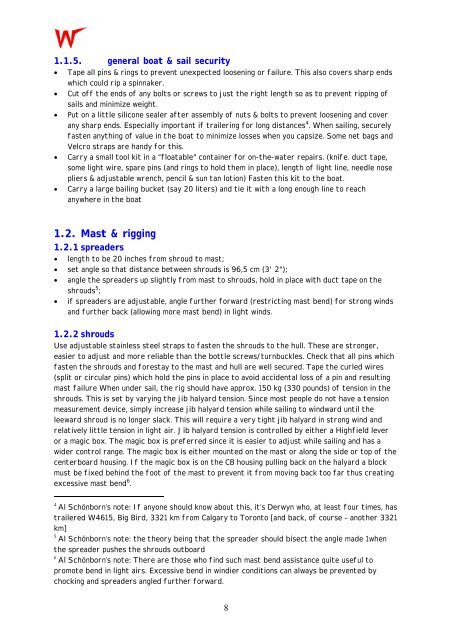File - Canadian Wayfarer Association
File - Canadian Wayfarer Association
File - Canadian Wayfarer Association
Create successful ePaper yourself
Turn your PDF publications into a flip-book with our unique Google optimized e-Paper software.
1.1.5. general boat & sail security<br />
• Tape all pins & rings to prevent unexpected loosening or failure. This also covers sharp ends<br />
which could rip a spinnaker.<br />
• Cut off the ends of any bolts or screws to just the right length so as to prevent ripping of<br />
sails and minimize weight.<br />
• Put on a little silicone sealer after assembly of nuts & bolts to prevent loosening and cover<br />
any sharp ends. Especially important if trailering for long distances 4 . When sailing, securely<br />
fasten anything of value in the boat to minimize losses when you capsize. Some net bags and<br />
Velcro straps are handy for this.<br />
• Carry a small tool kit in a “floatable" container for on-the-water repairs. (knife. duct tape,<br />
some light wire, spare pins (and rings to hold them in place), length of light line, needle nose<br />
pliers & adjustable wrench, pencil & sun tan lotion) Fasten this kit to the boat.<br />
• Carry a large bailing bucket (say 20 liters) and tie it with a long enough line to reach<br />
anywhere in the boat<br />
1.2. Mast & rigging<br />
1.2.1 spreaders<br />
• length to be 20 inches from shroud to mast;<br />
• set angle so that distance between shrouds is 96,5 cm (3' 2");<br />
• angle the spreaders up slightly from mast to shrouds, hold in place with duct tape on the<br />
shrouds 5 ;<br />
• if spreaders are adjustable, angle further forward (restricting mast bend) for strong winds<br />
and further back (allowing more mast bend) in light winds.<br />
1.2.2 shrouds<br />
Use adjustable stainless steel straps to fasten the shrouds to the hull. These are stronger,<br />
easier to adjust and more reliable than the bottle screws/turnbuckles. Check that all pins which<br />
fasten the shrouds and forestay to the mast and hull are well secured. Tape the curled wires<br />
(split or circular pins) which hold the pins in place to avoid accidental loss of a pin and resulting<br />
mast failure When under sail, the rig should have approx. 150 kg (330 pounds) of tension in the<br />
shrouds. This is set by varying the jib halyard tension. Since most people do not have a tension<br />
measurement device, simply increase jib halyard tension while sailing to windward until the<br />
leeward shroud is no longer slack. This will require a very tight jib halyard in strong wind and<br />
relatively little tension in light air. Jib halyard tension is controlled by either a Highfield lever<br />
or a magic box. The magic box is preferred since it is easier to adjust while sailing and has a<br />
wider control range. The magic box is either mounted on the mast or along the side or top of the<br />
centerboard housing. If the magic box is on the CB housing pulling back on the halyard a block<br />
must be fixed behind the foot of the mast to prevent it from moving back too far thus creating<br />
excessive mast bend 6 .<br />
4<br />
Al Schönborn’s note: If anyone should know about this, it’s Derwyn who, at least four times, has<br />
trailered W4615, Big Bird, 3321 km from Calgary to Toronto [and back, of course – another 3321<br />
km]<br />
5<br />
Al Schönborn’s note: the theory being that the spreader should bisect the angle made 1when<br />
the spreader pushes the shrouds outboard<br />
6<br />
Al Schönborn’s note: There are those who find such mast bend assistance quite useful to<br />
promote bend in light airs. Excessive bend in windier conditions can always be prevented by<br />
chocking and spreaders angled further forward.<br />
8


